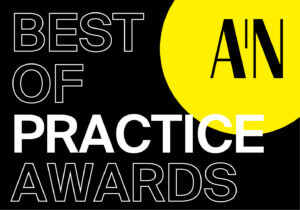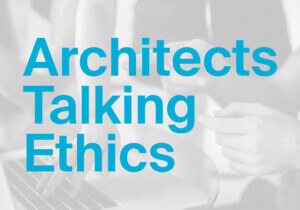The Architect’s Newspaper’s year-end Best of 2022 issue honors the winners, honorable mentions, and editors’ picks from our three awards programs: Best of Practice, Best of Products, and Best of Design. To open the Best of Practice section, AN Editor in Chief Aaron Seward sat down with AIA 2023 First VP/2024 President-elect Kimberly Dowdell to discuss her perspective on the profession and ambitions for her presidency.
Last summer in Chicago, delegates at the AIA’s annual meeting elected Kimberly Dowdell as the 2023 First VP/2024 President-elect. In 2024, she will be AIA’s 100th president, in addition to being the first Black woman and the first Millennial to hold the institute’s highest leadership role. A native of Detroit and marketing principal in HOK’s Chicago studio, Dowdell was previously president of the National Organization of Minority Architects (NOMA). She is a recipient of AIA’s Young Architects Award and is a member of the Cornell University Board of Trustees, where she earned a Bachelor of Architecture degree. Dowdell also holds a Master in Public Administration degree from Harvard.
Aaron Seward: What would you say are the major issues facing the profession of architecture?
Kimberly Dowdell: The general public doesn’t necessarily understand how relevant we are to the health and safety of the built environment that we all share. I believe AIA can take the lead on heightening the public understanding of what we do. There is also important work to be done relative to helping clients to really see the value that we create and compensate us accordingly so that we can deliver the best possible outcomes. That ties directly to talent, making sure that we both recruit and retain really strong design talent. If we can’t do that, then we are decreasing our relevance and our value. It’s like a cycle that we need to get ahead of so that we can make it a virtuous cycle in lieu of the opposite.
AS: What are your goals for your leadership within AIA?
KD: I want to take a closer look at the procurement process for design services and find ways to make it much more efficient. I’d like to help provide guidelines around how clients can optimally engage with architects. As a marketing principal, I see all kinds of RFPs and RFQs on a weekly basis, and I know that there’s some work that can be done to improve the process for architecture firms at all scales. I think there are ways to have conversations about the challenges with procurement so that both clients and service providers can benefit.
AS: In recent years, AIA has been trying to improve the equity, diversity, and inclusivity (EDI) of the profession. How far have we come with that and what more can be done?
KD: One of the reasons I’m super excited about being AIA President following Emily Grandstaff-Rice is because I got the opportunity to work with her when she was chair of the equity and future of architecture committee, or EQFA. I served on that committee as NOMA president in 2019 and 2020. One of the major milestones of the EQFA was publishing the guides for equitable practice, which are available on AIA’s website. The guides help practitioners understand what they can and should be doing to make a more equitable practice, as the name suggests. I think that has been an important deliverable created by AIA. It’s a series of living, breathing documents that will continue to evolve. The Architects Foundation is another important resource that helps to expand pathways into the profession, and I’m specifically thinking of its Diversity Scholars, who we hope are being cultivated to be part of the next generation of leaders in our profession.
I also think about what we’re doing at HOK. I’m one of the three cochairs for HOK’s Diversity Advisory Council (DAC). HOK has 26 offices around the globe, and we have representatives throughout the firm talk through the issues and opportunities to really help build culture within the firm. HOK is one example of that, but firms across the industry are doing similar things.
Having AIA as a convener to talk about what individual firms are doing helps firms learn from one another. For example, AIA Chicago might have a program and ask for insight on best practices, so I’ll point them to the EQFA guides for equitable practice and then talk about our practice and how we do things. I will also refer them to NOMA, which, I’m really excited to say, has recently become part of the Architectural Alliance, which includes AIA, NCARB, NAAB, ACSA, and AIAS.
AS: Have you seen a change in the culture in general, in terms of its awareness of EDI and its willingness to embrace it?
KD: I graduated college in 2006, and I feel like even back then there were conversations around the disparities in architecture.
In fact, I remember the cover of this one magazine had a silhouette of a Black woman, and it said our representation in the profession is 0.2 percent. It was a very striking graphic. And I recall thinking, “Oh, my, what have I gotten myself into?” Now the numbers are slightly better; it’s like 0.4 percent. Still not great. But the point I’m trying to make is, I feel like we’ve known about the disparities for a long time. I think it’s been an issue that sort of comes to the forefront in waves. There might be a groundbreaking article or a magazine issue that gets people talking about these things, and the topic goes away again, because there’s a recession, which is what happened in 2008. It makes sense that you have to prioritize keeping your practice afloat ahead of figuring out how to get different types of people in the practice. We saw a huge uptick in awareness of these issues after the tragic murder of George Floyd. A lot more investment has gone into issues around diversity. But now we have another recession pending. Hopefully, it’s not as bad as 2008, but I think there’s a lot of concern around that. So, one of my general concerns about the industry is just the cycle of the recessions and how that corresponds to the cycle of attention and resources put toward diversity. That’s one of the reasons why NOMA is valuable, because that’s always part of the conversation at NOMA.
AIA does provide financial and other forms of support to NOMA, which is an important commitment that had not always been present. It helps NOMA to do more work. AIA’s two strategic priorities are climate action and equity, so EDI is very much a part of the conversation, more so than it was five years ago.
AS: What about young people of minority backgrounds? Do you feel like there’s more interest in architecture as a profession than there used to be? Do they see architecture as something that they can pursue now more so than before?
KD: We can look at programs like NOMA’s Project Pipeline summer camps as well as the Hip Hop Architecture Camp, both of which help to spread the word about architecture to youth around the country. In recent years, there has been more attention to how to build a pathway for young people who are interested in pursuing design. There is a bit of a ground swell of interest from the K-12 group, however, we start to lose them when they realize the compensation doesn’t measure up to how cool architecture sounds.
AS: Right, they could earn more money becoming doctors and lawyers.
KD: Exactly, or they could join the the tech industry. That has definitely been eating into the profession’s share of talent, and we must confront it. This is one of the reasons why I’ve been vocal about profitability and value in architecture. There’s a correlation between being a young minority and having fewer resources than perhaps someone from the majority group. If you are in a position of being a first-generation college student and you have to provide for your family, choosing between being an architect, a doctor, a lawyer, or going into the tech field may be driven by earning potential. Even if you have a strong preference for architecture, all of these other options are going to allow for greater economic positioning. I think architecture is the coolest profession—you literally get to see and create the future—but then you see your bank account fresh out of school and you’re just like, “This doesn’t add up.” This is a challenge that our profession must take on in order to secure the future.
AS: In addition to the question of improved compensation to make architecture more attractive to people coming to the profession, there’s also the question of work-life balance in the architecture office. The younger generation seems to demand a lot more when it comes to that. What do you think the profession should do to address its work life balance concerns?
KD: At HOK, we conduct a Career and Opportunity Survey every other year. We issue a survey to our entire staff to get a better understanding of how they’re feeling about their work life balance, their compensation, the mentorship they’re receiving, and the leadership. The results give us a broad understanding of how each office is doing. Then we meet with the studio leaders to go through the results. We also compare the responses by gender, age, race, and location. I find that gathering that data is an important component of taking the pulse of where people are and how they’re feeling. I certainly recommend that firms find ways to get that information, so that they can confront the issues that are revealed from that anonymous feedback.
Overall, work-life balance is a hot topic for everyone, but I think it’s especially important for Gen Z. I’ve noticed that they’re good at articulating what they will and will not do at work.
AS: This year, we saw a campaign at SHoP Architects which didn’t lead to unionization and then, months later, Bernheimer Architecture, an office in New York, announced they were forming a union. It’s the first architecture union in about 80 years. How do you see this quest for unionization? Should architecture have unions, or not?
KD: I don’t have a firm position on it. I think it’s interesting as a concept. But it’s important to emphasize that architecture is a profession. We rely on our professional organizations to help advocate for the things we need. Let’s have a larger conversation about some of the fundamental challenges within the profession—firm culture, working conditions, work-life balance/flexibility, licensure, valuing people—and particularly, how we as a profession can do a better job of advocating for ourselves. Let’s figure out and agree on what the underlying problems are and work with not just AIA, but the entire ecosystem of organizations that have some level of responsibility for training, compensation, licensure—all of the things that play into how one feels about their position in the profession or their position in life. How do we ensure that people’s voices are heard and that we’re able to respond in reasonable ways?
I see unionization as an indicator of larger issues that we need to address as a profession that perhaps unionization itself won’t solve, but at least it lets us know that there’s a lot to discuss— and a lot to solve—together.











